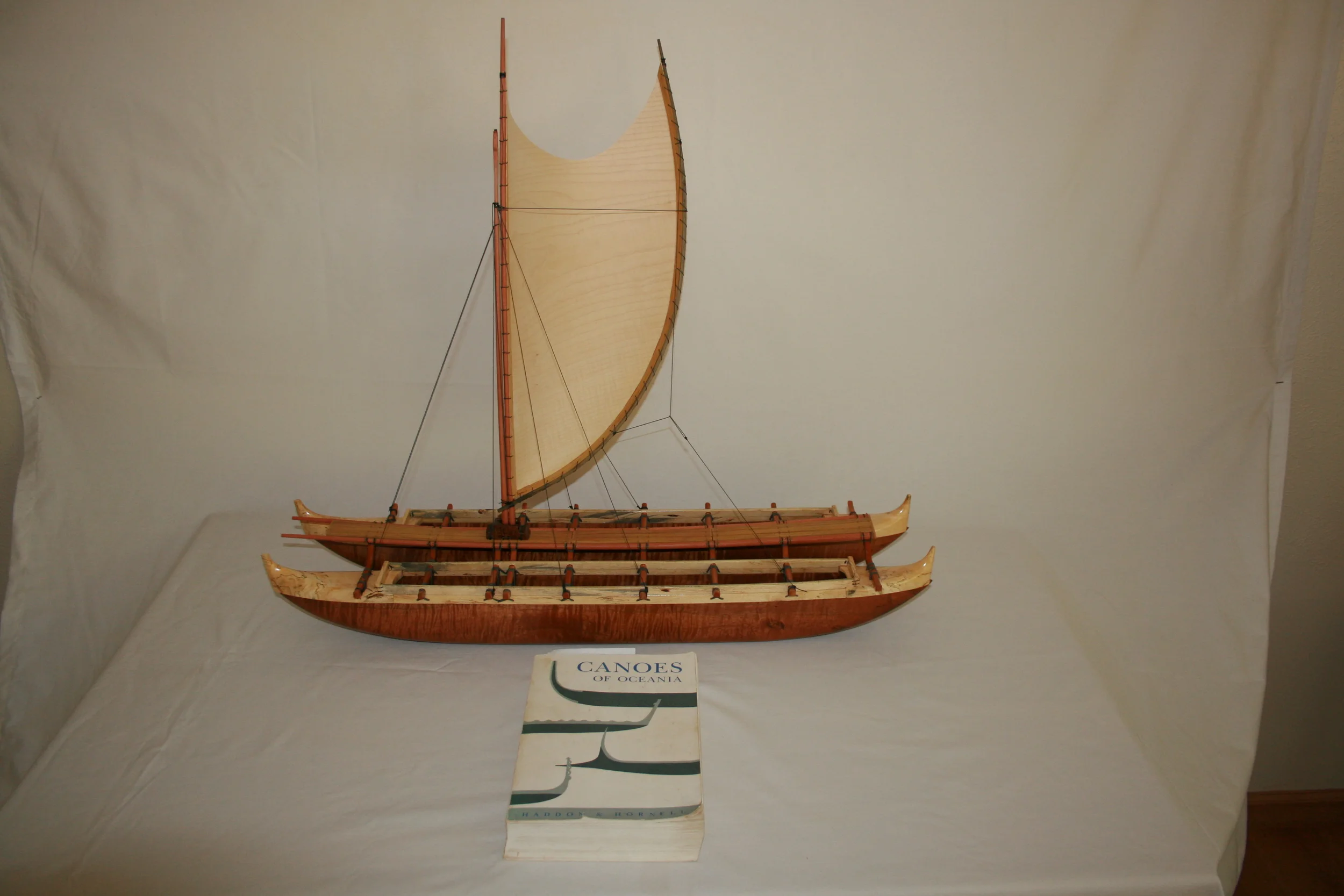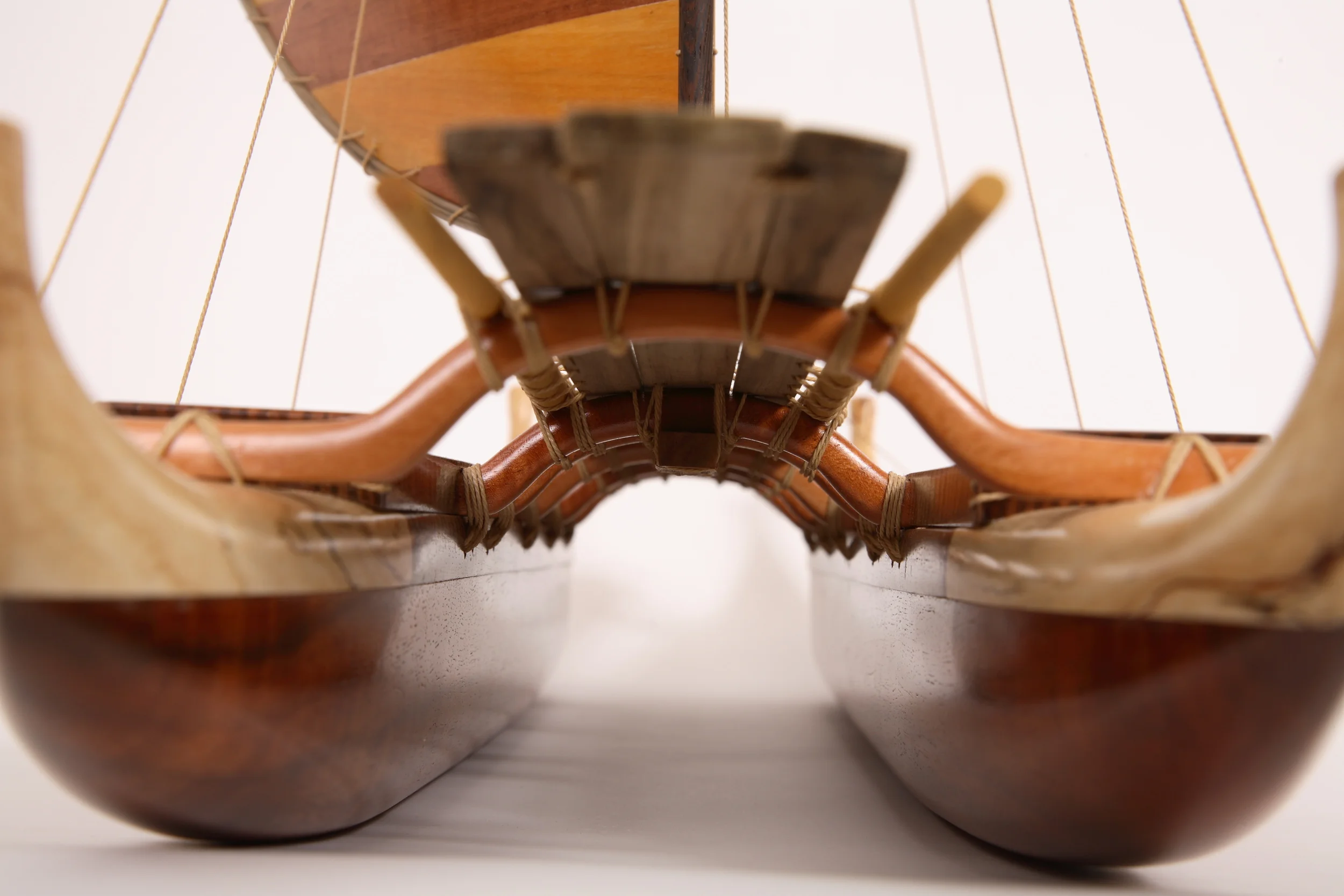



















Hawaiian Voyaging Canoes
This album illustrates Hawaiian Voyaging canoe models built over the years by Francis Pimmel. However, it does not include the Hokule'a , the most famous voyaging canoe, for which Francis created a separate album in this gallery.
Ancient Hawaiian voyaging canoes consisted of two identical hulls connected by arched cross booms. The curved booms raised the decking well over water, eliminating wave resistance and affording drier and more comfortable positions for passengers and freight.
A narrow wooden platform (deck) called the "pola"was laid on top of the arched cross booms, making it better suited for long-distance voyages. Sometimes a small straw hut was built on the deck for added protection. Double-hull voyaging canoes were rigged with a uniquely Hawaiian form of oceanic spirit sail called a "crab claw." The sail material for the Hawaiian crab claw was often matting made of finely plaited lauhala leaves, also called pandanus. The mats were overlapped horizontally and sewn up in reverse positions, thus giving the visual impression of matting of two different colors.
The historical significance of the Hawaiian voyaging canoes is further underscored by the renowned French naval architect Admiral Paris and the Englishman John Webber's 1778 sketches of 'Sandwich Islands' canoes. These sketches accurately depict the rigging and unique design of the Hawaiian-type sail, a testament to the enduring legacy of these canoes in maritime history. In the account of Cook's third voyages, the size of the largest Hawaiian Voyaging canoe, as measured, is given as 70 feet long, 12 feet broad, and 3.5 feet deep.
It is truly awe-inspiring to learn that an old wrecked voyaging canoe on the coast of Hawaii was a staggering 108 feet long. These canoes were not just large, but also incredibly robust, capable of carrying up to 140 men. Such feats of maritime engineering are a testament to the skill and resourcefulness of the ancient Hawaiians.
Hawaiian Voyaging Canoes
This album illustrates Hawaiian Voyaging canoe models built over the years by Francis Pimmel. However, it does not include the Hokule'a , the most famous voyaging canoe, for which Francis created a separate album in this gallery.
Ancient Hawaiian voyaging canoes consisted of two identical hulls connected by arched cross booms. The curved booms raised the decking well over water, eliminating wave resistance and affording drier and more comfortable positions for passengers and freight.
A narrow wooden platform (deck) called the "pola"was laid on top of the arched cross booms, making it better suited for long-distance voyages. Sometimes a small straw hut was built on the deck for added protection. Double-hull voyaging canoes were rigged with a uniquely Hawaiian form of oceanic spirit sail called a "crab claw." The sail material for the Hawaiian crab claw was often matting made of finely plaited lauhala leaves, also called pandanus. The mats were overlapped horizontally and sewn up in reverse positions, thus giving the visual impression of matting of two different colors.
The historical significance of the Hawaiian voyaging canoes is further underscored by the renowned French naval architect Admiral Paris and the Englishman John Webber's 1778 sketches of 'Sandwich Islands' canoes. These sketches accurately depict the rigging and unique design of the Hawaiian-type sail, a testament to the enduring legacy of these canoes in maritime history. In the account of Cook's third voyages, the size of the largest Hawaiian Voyaging canoe, as measured, is given as 70 feet long, 12 feet broad, and 3.5 feet deep.
It is truly awe-inspiring to learn that an old wrecked voyaging canoe on the coast of Hawaii was a staggering 108 feet long. These canoes were not just large, but also incredibly robust, capable of carrying up to 140 men. Such feats of maritime engineering are a testament to the skill and resourcefulness of the ancient Hawaiians.
A 42 inch long scale model of a Hawaiian Voyaging Canoe
Commissioned in 2017 by the Bank of Hawaii, main branche, Honolulu.
The commissioned Hawaiian Voyaging Canoe being installed within its showcase at the Bank of Hawaiia, main branche, Honolulu.
On permanent display at the Bank of Hawaii, main branche, Honolulu.
Iosepa
Iosepa mid section
Iosepa forward section
Iosepa stern section
Iosepa for PCC
Iosepa for PCC front section
Hawaiian voyaging canoe Herb Kane
Hawaiian voyaging canoe Herb Kane
Iosepa 12 inch